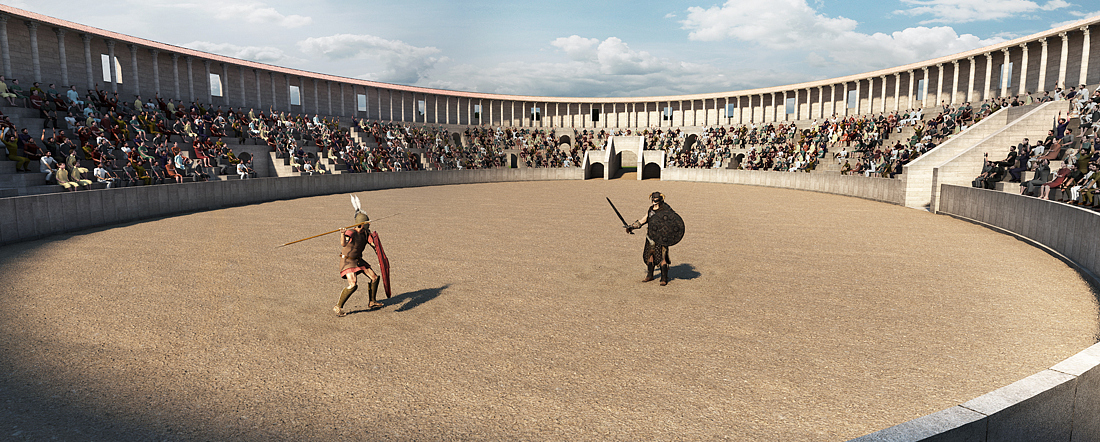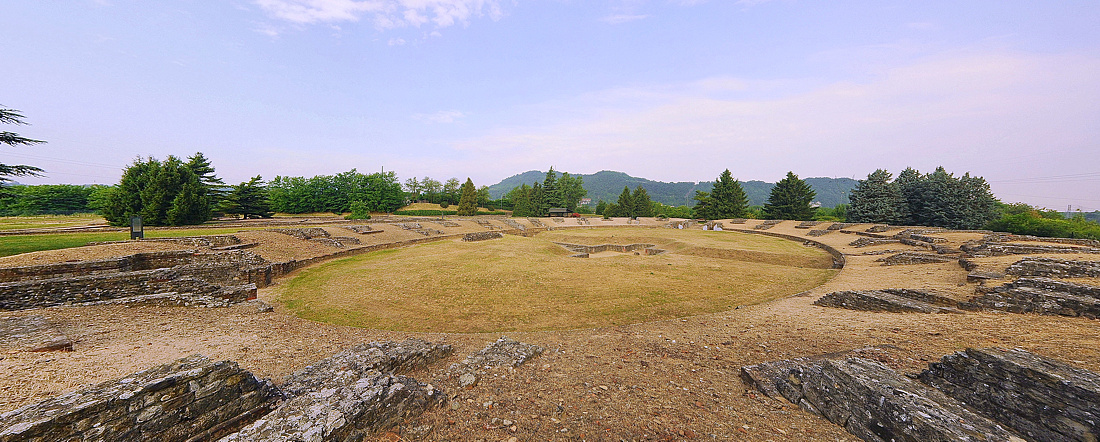
The Amphitheatre
The amphitheatre was a building for performances, with an elliptic plan, where munera (gladiator combats) and venationes (wild beast hunts) took place.
Since this type of building spread out relatively late, the location of the amphitheatre is (almost) always marginal within the city. This also happened for problems of public order and to facilitate the access and flow of large masses of spectators. Therefore, the amphitheatre often rose outside the city walls. However in some cases there is also evidence for monuments located inside the city.
This is the case for Libarna, where the amphitheatre, built in the first century AD, stood within the urban boundaries, in the eastern sector of the city, perfectly integrated in the urban plan and in line with the decumanus maximus and the cardines. The building occupied an area equivalent to two blocks and was surrounded by an open space lined by a rectangular precinct, with the function of integrating the plan of the building into the orthogonal grid. The main entrance was likely on the western long side, aligned with the decumanus maximus. Three other entrances opened at the edges of the ellipse axes. In particular, the northern and southern entrances were used during the procession inaugurating the games and for transporting outside men and beasts killed or injured during the performances.
The building belonged to the so-called “type with segmented embankment”, different from the canonical model, which was completely built with an undifferentiated sequence of superimposed arches, radial walls and annular galleries, as in the case of the Colosseum. The building had a sunken arena with bleachers (cavea) on an artificial embankment supported by annular retaining walls and a system of pairs of radial walls, which housed the stairs to reach the upper seats accessible through vaulted galleries (vomitoria). A special platform was reserved for the authorities.
According to the reconstruction hypothesized by the excavators, the external perimeter was arranged on two orders. The masonry consisted of rectangular blocks of stone set in lines alternating with rows of bricks, with an internal core made of cement. Lesenes, bases and horizontal mouldings were made of sandstone. The surface of the arena was in earthen floor and delimited by a podium about two meters high.
In the middle stood some underground service rooms, likely covered by a wooden ceiling. Used to host machines and rise tools, animals and human beings during the show, they were accessible through galleries from the eastern and western entrances.
To protect the spectators from sun and rain, the building might have been covered with large clothes fastened to poles which were anchored to the external wall and driven by pulleys.
The amphitheatre is a venue for performances typically in the Italian tradition, unlike the theatre whose model derived from the Greek world. The history of this building does not go hand in hand with the games which took place there, since the institution of the games is much older than the first amphitheatres (established in Etruria and Campania in the fourth century BC).
As far as the Roman world is concerned, it was only in 264 BC that Decimus Iunius Brutus arranged a combat between pairs of gladiators in the Forum Boarium, to honour his deceased father.
The sources attest that these shows were such successful among the public that it became urgent to move them to the Forum Romanum. Here a system of galleries were arranged below the pavement of the square to be used for performing the shows. During the munera, the spectators sat on wooden platforms appositely set for the event.
From the Augustan period the performances moved into the Campus Martius, in the Saepta, the venue destined for electoral meetings, despite the Urbs was equipped with an amphitheatre already since 29 BC, that of Statilius Taurus. This, however, was too small to meet the needs of the metropolis.
The first large amphitheatre was built relatively late in Rome. The Flavian Amphitheatre, in fact, known as Colosseum, was begun by Vespasian in AD 71-72 and completed under the rule of his son Domitian, while in southern Italy these buildings were already attested since the end of the second century BC (Pozzuoli and Capua).



 Italiano
Italiano Français
Français

